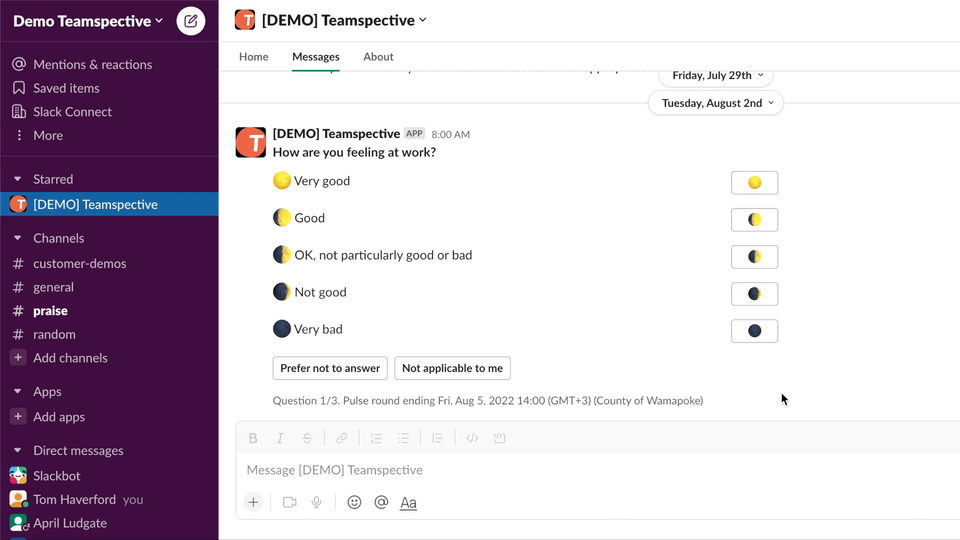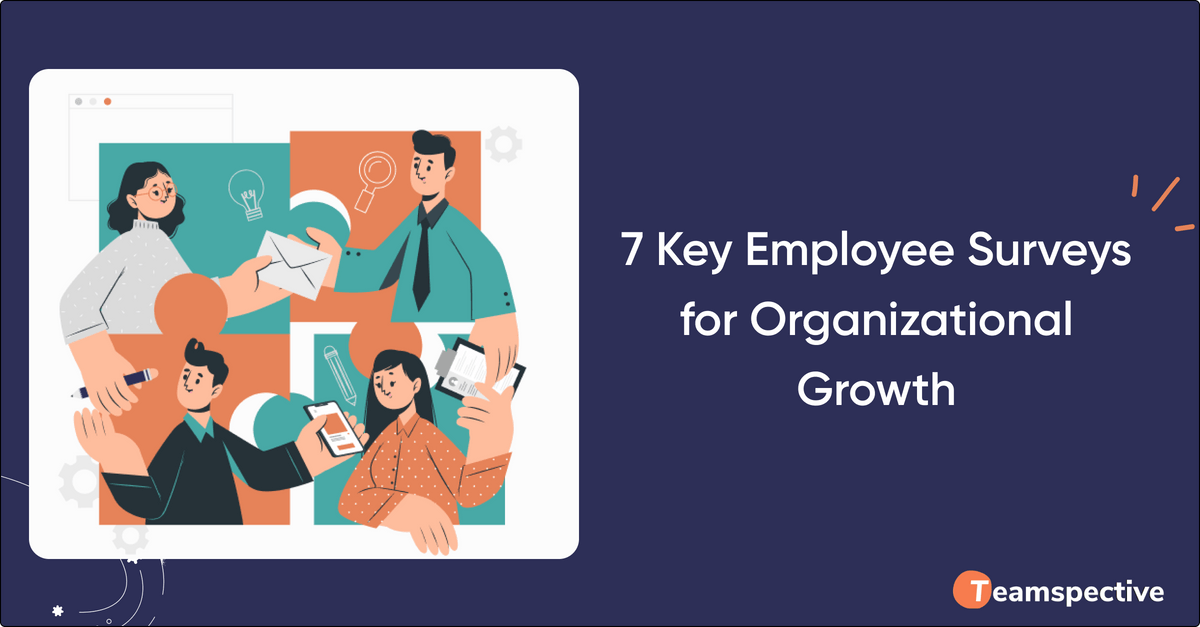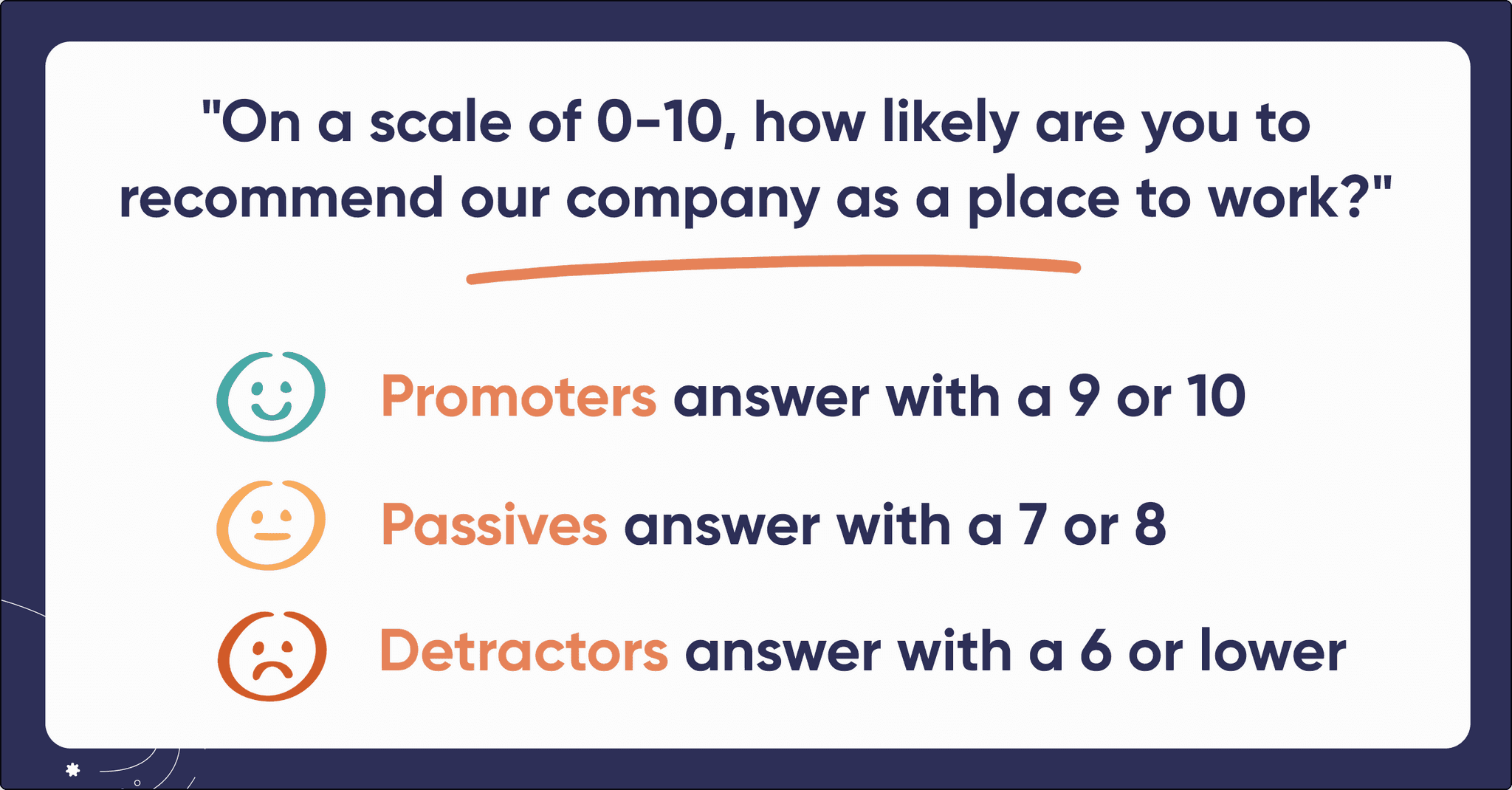Table of Contents
- Engagement Surveys
- Pulse Surveys
- eNPS (Employee Net Promoter Score) Surveys
- 360-Degree Feedback Surveys
- Exit Surveys
- Culture Surveys
- Onboarding Surveys
Introduction
Employee surveys are essential for staying on the pulse of your workplace and ensuring organizational growth and satisfaction. While different types of surveys can be used for various purposes, there is no single survey that captures all aspects of employee sentiment.
This guide delves into the different types of employee surveys, each designed to gather specific data points and insights, enabling organizations to make informed decisions and foster a positive work culture.
1. Organizational Survey: Engagement Surveys
Engagement surveys are vital in measuring the degree of employee engagement and identifying factors that influence it. These surveys assess various dimensions of engagement, such as emotional commitment, alignment with company goals, and willingness to go above and beyond.
Key things measure by employee engagement surveys are:
- Employee satisfaction and commitment
- Alignment with company values and objectives
- Motivation and empowerment
- Workplace relationships and collaboration
- Barriers to engagement
The insights gained help organizations pinpoint areas needing improvement to enhance engagement levels, which in turn can lead to increased productivity, retention, and overall performance. It is also a helpful practice to compare your company’s results to industry benchmarks to get a better idea of where you stand.
Employee engagement surveys are extensive and typically conducted once or twice per year, although there is some variance in frequency between organizations. The biggest challenge of engagement surveys is that while they provide a lot of deep detail, they only show a snapshot of employees' feelings at the time of the survey. This makes it hard to take action quickly, or to prevent issues from arising in the first place as they might be discovered only after they’ve escalated.
The slower cadence between engagement survey rounds also means it is hard to measure the impact of corrective actions taken because the next survey round will happen only after several months. This is where pulse surveys come in.
2. Organizational Survey: Pulse Surveys
Pulse surveys are short, frequent surveys designed to quickly gauge the mood of employees or assess their opinions on specific issues. Due to their brevity and frequency, pulse surveys are an excellent tool for keeping a continuous check on employee sentiments, allowing leaders to act swiftly on any emerging issues or trends.
Due to the rapid cadence between survey rounds, pulse surveys allow real-time monitoring of the impact of changes made and empower team leaders to address team-specific issues with less supervision required.
Pulse surveys work great for gathering data on various topics:
- Immediate employee sentiments: Provide a snapshot of employee morale at any given time: the current mood and feelings of employees about their work environment, team dynamics, and overall job satisfaction.
- Reaction to recent changes: Gauge employee reactions to recent organizational changes, initiatives, or events, allowing leaders to understand the impact of decisions and adapt strategies accordingly.
- Engagement trends over time: Track changes in employee engagement and sentiment frequently and over time, quickly identifying trends and patterns that may require attention.
- Specific issues or challenges: Assess specific areas of concern or interest, such as the effectiveness of remote work arrangements, understanding of new policies, or the impact of workload changes.
- Feedback on leadership and support: Assess leadership effectiveness, communication, support, and resources available, and identify areas for improvement in management practices and support structures.
For a more detailed overview of Pulse Surveys, see our guide: The Definitive Guide to Pulse Surveys in 2024

A snapshot of Teamspective's pulse surveys
3. Organizational Survey: eNPS (Employee Net Promoter Score) Surveys
The eNPS survey is a derivative of the Net Promoter Score (NPS), adapted to measure employee loyalty and their likelihood to recommend the organization as a great place to work. It typically consists of a single question: “How likely are you to recommend your organization as a place of employment to friends or family?”. This allows organizations to assess the overall employee sentiment and loyalty, which are critical indicators of organizational health and employee satisfaction.
Key aspects eNPS surveys are designed to measure include:
- Employee loyalty and advocacy: eNPS surveys directly measure the likelihood of employees recommending the organization as a great place to work, serving as a gauge of overall employee loyalty and satisfaction.
- Organizational health and culture: The eNPS score can indicate how positive and supportive the work environment is perceived to be by employees.
- Engagement and retention: High eNPS scores are often correlated with higher employee engagement and retention rates, indicating a strong sense of belonging and commitment among the workforce.
- Performance benchmarks: eNPS allows organizations to benchmark their performance against industry standards and track progress over time, providing a simple metric to assess improvements.
The downside of eNPS surveys is that they do not provide context for what caused low or high scores. This is why it is recommended to integrate this question into other types of surveys. For example, Teamspective’s Pulse Surveys incorporate the eNPS question and survey admins can control how frequently it is asked.
Read more about eNPS surveys in our guide: Understanding eNPS: A Comprehensive Guide for Businesses
4. Organizational Survey: 360-Degree Feedback / Performance Evaluation Surveys
360-degree feedback surveys provide a comprehensive view of an employee’s performance, gathering feedback from a wide range of sources, including supervisors, peers, subordinates, and sometimes even clients. This holistic approach to feedback helps individuals understand how their work is perceived from different perspectives, highlighting strengths and areas for development. It promotes a culture of transparency and continuous improvement, contributing to personal and professional growth.
360-degree feedback surveys can be used to measure several things:
- Professional development needs: By compiling perspectives from different stakeholders, 360-degree feedback identifies specific areas where an employee can improve and grow professionally, helping to tailor personal development plans.
- Strengths and achievements: Besides identifying areas for improvement, these kinds of employee surveys highlight an employee’s strengths and achievements, reinforcing positive behaviors and contributions to the team and organization.
- Communication and interpersonal skills: 360-degree feedback surveys often assess how effectively an employee communicates and interacts with others, providing insights into their interpersonal skills, teamwork capabilities, and leadership qualities.
- Alignment with company values: They can evaluate how well an employee's actions and decisions align with the organization’s values and culture, ensuring that the workforce is cohesive and aligned towards common goals.
As performance evaluations are quite heavy to run, it doesn’t make sense to do them very frequently. However, doing them only once per year may be too infrequent to provide meaningful development for people. Our recommendation is to run them at least bi-annually or even once per quarter. This ensures that employees get enough meaningful feedback.
5. Organizational Survey: Exit Surveys
Employee surveys should also be conducted when a person leaves the company – understanding why employees leave is as important as knowing why they stay. Exit surveys offer direct insights into the reasons behind employee departures, and one of the main benefits of them is that departing employees are often the most candid about problems they perceive within the organization.
Key things exit surveys can identify include:
- Reasons for leaving: Uncover the specific reasons why employees decide to leave the organization, whether it's related to job dissatisfaction, career advancement opportunities elsewhere, management issues, or personal reasons.
- Employee satisfaction and engagement levels: Gauge the departing employee's satisfaction and engagement levels during their tenure, and identify any persistent issues or trends that may be affecting overall employee morale and retention.
- Feedback on management and leadership: Exiting employees can offer feedback on their direct managers, leadership, and the overall management style within the organization, including areas for improvement.
- Work environment and culture: Assess the employee's perception of the work environment and company culture, highlighting both positive aspects and areas for improvement.
- Recommendations for improvement: Departing employees can offer great suggestions for improvement and offer unique insights into potential changes or initiatives that could benefit the organization in the future.
6. Organizational Survey: Culture Surveys
Culture surveys evaluate the underlying beliefs, behaviors, and values that make up the organizational culture. This kind of employee survey can identify areas where the culture may be strong and areas that may require changes or attention from leadership.
Culture surveys can be used to measure are the following:
- Alignment with core values: How well the behaviors and attitudes of employees align with the organization's stated core values and mission. Helps identify gaps between ideal and actual organizational culture.
- Perception of work environment: Employees' perceptions of the level of support, collaboration, and respect experienced within the team and the broader organization.
- Inclusivity and diversity: The effectiveness of diversity, equity and inclusion (DEI) initiatives, gauging how inclusive the workplace culture is and identifying areas where improvements can be made.
- Communication and feedback: The quality and effectiveness of internal communication and feedback mechanisms, determining whether employees feel heard and whether communication facilitates or hinders their work.
- Engagement and empowerment: The extent to which employees feel engaged with their work and empowered to make decisions, take initiative, and contribute to the organization's success, providing insights into how culture affects motivation and productivity.
7. Organizational Survey: Onboarding Surveys
Feedback from new hires on their onboarding experience is critical for improving the process and ensuring new employees feel welcomed and well-informed. Such surveys also help leaders ensure that new employees are well-integrated into the organization. Employee onboarding surveys can highlight strengths and gaps in the onboarding process, and the feedback is invaluable for refining onboarding practices, ultimately enhancing the new hire experience and reducing early turnover.
The most essential things onboarding surveys can measure include:
- Clarity of role and expectations: How well new employees understand their job roles, responsibilities, and performance expectations from the start.
- Effectiveness of onboarding programs: The overall effectiveness of the onboarding process, including orientation sessions, training programs, resources and tools needed to begin work efficiently.
- Integration into company culture: How well new hires feel they have been integrated into the company culture, including their sense of belonging and acceptance within their teams and the organization as a whole.
- Areas for improvement: Suggestions for improving the onboarding experience and identifying specific areas where the process could be improved to better support new hires in their early days and weeks at the company.
Conclusion
Employee surveys are a powerful tool for gaining insights, enabling organizations to make data-driven decisions that foster a positive, productive, and engaging work environment. Each type of survey serves a unique purpose, from understanding employee engagement and satisfaction to improving performance and organizational culture. By implementing and acting upon the feedback from these surveys, organizations can enhance employee experiences, leading to improved retention, performance, and overall organizational success.
Teamspective can help you get started with collecting survey data and insights fast, enabling you to take action and drive concrete improvements. Want to learn more about how your organization benefits from our platform or want to see a product demo? Get in touch and let's get started!


